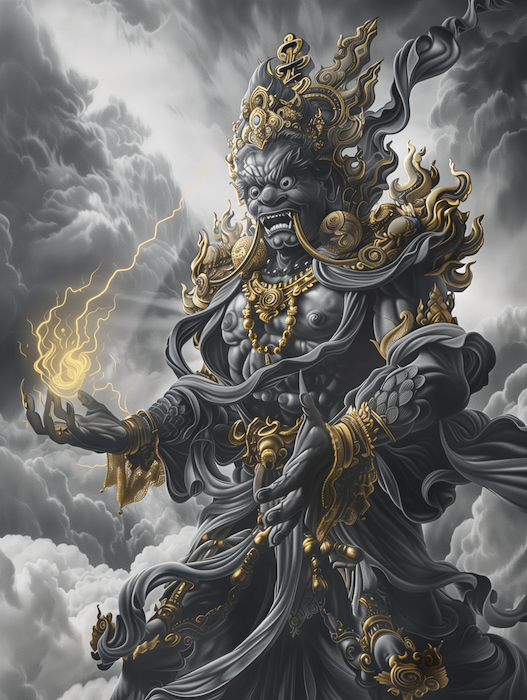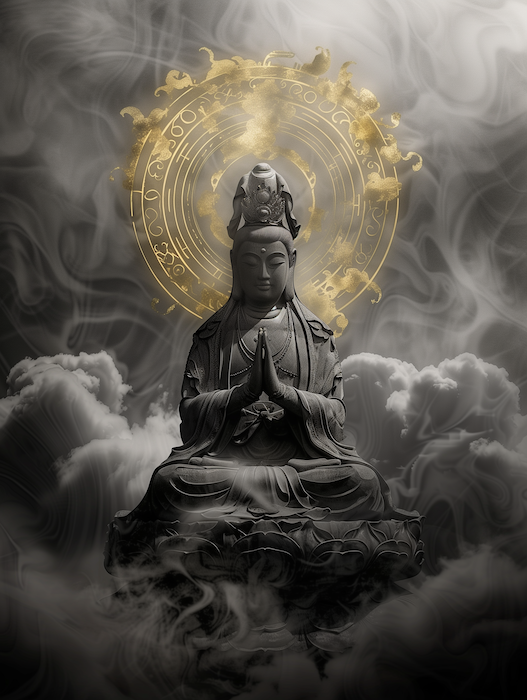
Vajrapani: the Protector of Shaolin
Vajrapani is a deity with special significance for Shaolin Temple who is rich with symbolism. Could he also represent the skill of electric-like qi emission? As discussed below, this idea may not be too much of a stretch.
Vajrapani is the patron Bodhisattva and protector deity of Shaolin Temple. In Chinese he is called Jingang Shou Pusa (金刚手菩萨), literally, “holder of the vajra.” The vajra is both a symbolic ritual object and a weapon, and could be translated from Sanskrit as either “thunderbolt” or “diamond.” Vajrapani is a deity that is not only seen as a protector and source of strength, but also represents some of the most interesting juxtapositions found in Shaolin–a Buddhist community that produced meat-eating, warrior monks1. Wielding the vajra, he represents a number of things including power, protection, healing capacity, spiritual attainment… perhaps even the phenomena of electric-like qi emission.
Vajrapani is one of the earliest bodhisattvas to appear in Mahayana Buddhism and is said to have been a protector and guide to Guatama Buddha. He is said to represent the Buddha’s power and is often grouped into a trinity with Avalokitesvara (Guanyin Bodhisattva 观音菩萨) who represents the Buddha’s compassion and Manjushri (Wenshu Bodhisattva 文殊菩萨) who represents the Buddha’s wisdom.

For Shaolin, Vajrapani is seen as a manifestation of Guanyin due to a passage in the Lotus Sutra which states that Guanyin will assume whatever form is conducive to spreading the dharma. This is why some Shaolin works of art show Guanyin in a bubble floating above Vajrapani.

For Shaolin, Vajrapani is seen as a deity who provides strength and power. The martial abilities of Shaolin monks came in handy when the monks needed to take up arms to defend themselves and the monastery during several historical events. Vajrapani also provided the monks with religious sanction for the violence necessary in such instances. It can be reasoned that if the Buddha needed a guardian such as the fighting deity Vajrapani, then certainly his monastic community could employ the protection of fighting monks. Vajrapani himself also exhibits the characteristics of someone who has undergone the type of cultivation that employs a combination of external and internal gong, resulting in a sinewy physique and the capability of wielding lightning bolts, perhaps both literally and metaphorically. Shaolin has long been associated with “tendon changing” neigong practices such as the legendary Yijinjing. Shaolin monks who cultivate in this way at the highest levels are famous for developing gong that enables them to break bricks and stones and a seemingly superhuman ability to withstand devastating attacks with weapons (i.e. iron body, golden bell, etc). A less publicized skill associated with these practices is the ability to manipulate qi in a way that can result in powerful emissions of electric and/or thermal energy.

The vajra (jingang 金刚) was an object also associated with the Vedic deity Indra, and while it is considered a weapon that can be used for protection and to subjugate both external or internal obstacles, it has several layers of meaning beyond that. As a lightning bolt, it symbolizes power and the active and forceful approach to spiritual cultivation that uses skillful means to cut through ignorance and fear on the path towards enlightenment. As a diamond, it can destroy but itself is indestructible and unchanging like the all-pervading primordial nature of reality (i.e. sunyata, emptiness).
Lightning and thunder are largely considered primordial forces of nature employed by the gods, both within Eastern mythology and elsewhere. In China, there is also a class of ritual practice seen in many Daoist lineages dating back to the Song Dynasty called leifa (雷法) “Thunder Rites” that is based on utilizing the power of thunder and lightning for exorcistic purposes. Exorcism can be seen as a type of healing modality, especially considering that historically many illnesses were associated with some sort of possession. These practices typically involve a practitioner making use of rituals, talismans, and seals to summon thunder deities (Leishen 雷神) for the purpose of exorcizing demons. As pointed out in his study on society and the supernatural in Song China, Edward L. Davis highlights how at this time, due to the leifa movement, “thunder was transformed from a manifestation of nature in to the controlling power of the cosmos itself, the pivot of Heaven and Earth and the power of transformation behind the continuous alternation of yin and yang. The point of Thunder Magic, therefore, was to plug into this cosmic force and, as one text says, literally to ‘hold the power of transformation in the palm of one’s hand.’” He goes even further and connects leifa to the internal arts when he mentions neidan (“inner elixir” or “inner alchemy”) and other practices, stating another dimension of leifa in which “the practitioner learned to reproduce and store thunder within his own body.” 3
Given the symbolism of Vajrapani within Shaolin, the trends throughout China in which lightning is associated with exorcism and healing (as in the leifa tradition), the historical evidence of qi emission, and the contemporary masters capable of the electric-like qi emission (including the late Xuan Kong of Gengmenpai, a Shaolin monk who stayed at the Shaolin temple during pre-Cultural Revolution times); it is then not much of a stretch to posit that Vajrapani could also symbolize the healing and martial skill of fagong (发功), i.e. electric-like qi emission. What else could be as literal an embodiment of “holding the power of transformation/[thunder] in the palm of your hand?”
Could the connection between Vajrapani, thunderbolts, and electric-like qi cultivated in the body also have significance for spiritual cultivation beyond the metaphors of thunderbolt and diamond mentioned above? Legendary adepts who produced some of China’s most well-known Daoist and internal cultivation literature have, in a number of famous works, classified the end goals and usefulness of various types of cultivation practices. These are generally in agreement that practices that build energy like this in the body at best result in good health and long life. However, an abundance of (post-heaven) qi and open meridians certainly will take one beyond what is conventionally considered to be “good health,” and importantly, are considered foundational milestones in many schools of Chinese internal cultivation. As explained by teachers from several lineages that I have trained under, the more qi that is cultivated and stored in the lower dantian via foundational neigong practice, the easier we can attain meditative stillness, the clearer our shen 神 will become, and the easier (and safer) it will be when approaching the stillness-based and meditative practices that are important for spiritual cultivation.
Notes and References
1. Shaolin monastics living inside the monastery observe a strict vegetarian diet. However, there are various types of monks surrounding Shaolin including some who are ordained at Shaolin but live outside the temple grounds, teach martial arts schools, and freely eat meat.2 Also of interest is a Tang dynasty story of a historical Shaolin monk named Sengchou who was said to have prayed to Vajrapani for assistance and in return Vajrapani force-fed him meat and granted him supernatural strength.
2. Meir, S., 2008: The Shaolin Monastery: History, Religion, and the Chinese Martial Arts. University of Hawai’i Press.
3. Davis, E. L. 2001: Society and the Supernatural in Song China. Honolulu: University of Hawai‘i Press, 2001, 25–26; also partly quoted in Capitanio, “Dragon Kings and Thunder Gods”, 204. (via reference 4, below)
4. Meinert, C. 2013: Buddhist Traces in Song Daoism: A Case From Thunder-Rite (Leifa) Daoism. http://dx.doi.org/10.2218/ejecar.2013.1.735
5. Pregadio, F. 2008: The Encyclopedia of Taoism. Routledge.
6. Vajrapani. Foundations of Buddhism Wiki. http://cubuddhism.pbworks.com/w/page/24906373/Vajrapani

